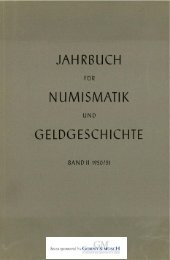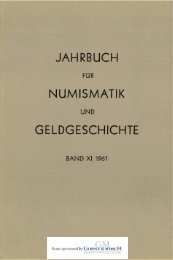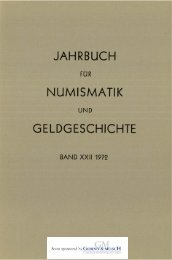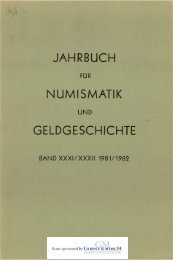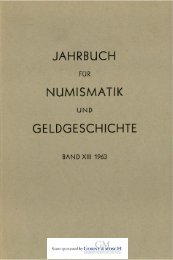28 David MacDonaldBabelon's hypothesis of its significance. Rather, the issue ought to be seenin the light of the eclectic choice of coin types typical of some Greekcoinages during the late sixth century B.C. and early fifth centuries B.C.Athens, for instance, struck Wappenmünzen in a variety of types beforeadopting the Gorgoneion/lion "national" type and then finally settling onthe Athena/owl coinage, which, of course, became the standard typethroughout the fifth and fourth centuries. Chalkis first struck a stater bearinga quadriga/incuse. Fractions bore a horseman with a spare horse and ahorseman alone. These were replaced in turn by a head/quadriga issue, andthen by an eagle/wheel issue apparently struck over the course of severaldecades, for there are a number of variations: the form of the wheel variesgreatly on different coins, the incuse containing the wheel may be eithersquare or triangular, a three Letter ethnic appears on some coins, and on thelater coins the eagle clutches a snake in apparent imitation of the earlieststaters of Elis. Some mints struck a great variety of types, while others struckvariations of a single type. The standardized types that characterize many ofthe coinages of the fifth and fourth centuries were in the process of developmentduring the later sixth century.The borrowing of coin types, such as Chalkis' copying of the Elis eagle andsnake, was also common in the late sixth and first half of the fifth centuries.Examples can be multiplied at great length, but one is of immediaterelevance. Tanagra struck during the first half of the fifth century with thetypical obverse type of the heroic shield and the reverse type of a "Chalkidian"wheel — exactly the same combination of types present on the earliershield/wheel issue in question.21In this context of experimentation and copying, variations in coin typescannot be vested automatically with the sorts of political implications thathave been read into the shield/wheel issue. One would be hard pressed tocite contemporary issues announcing the formation of an alliance or joiningof a league. 22 A symmachia between Chalkis and Elis cannot reasonable be21BMC Central Greece, pp. 60-61 nos. 9-21; B.V. Head, On the Chronological Sequenceof the Coins of Boeotia (London, 1881), pp. 21-22, noting the similarity to the Chalkidianshield/wheel issue.22Few issues unambiguously indicate any sort of inter-city relations, and those do notnecessarily indicate military alliances. Commercial relations, monetary conventions,religious, festival, and agonistic alliances are all possibilities. It is possible that one groupof electrum staters was issued by the allies during the Ionian Revolt, but Kraay, Archaic,30 rightly points out that decisive proof of any connection between the coins and the revoltis lacking. Other likely military alliance coins are the EYN marked coins, which date tothe early fourth century (Kraay, Archaic, pp. 248-249 and literature cited there), but eventhere the character of the coinage is debatable and unclear. It has been held to representboth a pro-Spartan and anti-Spartan combination. In fact, there is no compelling proof thatit represents a military alliance. The coinages of the Boiotian and other leagues were, of
Significance of „Boiotian League/Chalkis" Silver Issue 29argued on the basis of the shared eagle-and-snake obverse type, nor can it bemaintained on the basis of the Tanagra issue that Chalkis had formed analliance or actually joined the Boiotian League23 shortly after the PersianWars. Similarly, the shield/wheel coin should be seen as symply a short-livedissue struck probably at Chalkis late in sixth century, a period in whichchanges in coin types were yet common and neither the heroic shield northe wheel was identified with specific league or polis.course, struck by existing political structures, not coinages struck upon the formation ofan alliance. It is, moreover, not apparent that the Boiotian-Chalkis alliance of c. 507 B.C.would have had the opportunity or reason to produce coinage.23Babelon, Traite III, p. 974 no. 1372; C.T. Seltman, Athens, its History and Coinage beforethe Persian Invasion, Cambridge 1924, 92-93 do attempt to equate the Tanagrashield/wheel issue with the alliance of c. 507 and the shield/wheel issue presumably struckat Chalcis. The style, fabric, and legends of the Tanagra coins, however, all indicate a datewell into the fifth century; B.V. Head, On the Chronological Sequence of the Coins ofBoeotia, London 1881, 20-23 dated them thusly over a century ago, and the concensus ofnumismatic opinion continues to agree, e.g. Kraay, Archaic, 110.
- Seite 1: JAHRBUCHFÜRNUMISMATIKUNDGELDGESCHI
- Seite 5 und 6: JAHRBUCHFÜRNUMISMATIK UND GELDGESC
- Seite 7 und 8: INHALTVorbemerkung der Redaktion 7G
- Seite 9: 7Vorbemerkung der RedaktionEntgegen
- Seite 12 und 13: 10 Gerd DethlefsDie Zeichnung befin
- Seite 14 und 15: 12 J.Elayi, A.G.Elayiexplicit inscr
- Seite 16: 14 J. Elayi, A.G.Elayione bears on
- Seite 19 und 20: Abbreviations Used by Byblos,Tyre a
- Seite 21 und 22: Abbreviations Used by Byblos,Tyre a
- Seite 23 und 24: Abbreviations Used by Byblos,Tyre a
- Seite 25 und 26: Jahrbuch f. Numismatik u. Geldgesch
- Seite 27 und 28: Significance of „Boiotian League/
- Seite 29: Significance of „Boiotian League/
- Seite 34 und 35: 32 Peter F. Dorceycoinage. Accordin
- Seite 36 und 37: 34 Peter F. Dorceyquem of 120.'° A
- Seite 38 und 39: 36 Peter F.DorceyEETI(AI)2° and HP
- Seite 40 und 41: 38 Peter F. DorceyTable I: Catalogu
- Seite 42 und 43: 40 Peter F.DorceyTable II: Coin Hoa
- Seite 44 und 45: 42 Allan A. LundDer Germanenbegriff
- Seite 46 und 47: 44 Allan A. Lundnen sie, wie die Fo
- Seite 48 und 49: 46 Allan A. Lunddie Angaben über d
- Seite 50 und 51: 48 Allan A. Lundw a 200 Kilometer b
- Seite 52 und 53: 50 Allan A. Lundrelle Grenze fielen
- Seite 55 und 56: Jahrbuch f. Numismatik u. Geldgesch
- Seite 57 und 58: Ein weiterer Aureus des Pescennius
- Seite 59 und 60: Jahrbuch f. Numismatik u. Geldgesch
- Seite 61 und 62: 1Bronzeprägung von Laodikeia in Sy
- Seite 63 und 64: Bronzeprägung von Laodikeia in Syr
- Seite 65 und 66: Bronzeprägung von Laodikeia in Syr
- Seite 67 und 68: Bronzeprägung von Laodikeia in Syr
- Seite 69 und 70: Bronzeprägung von Laodikeia in Syr
- Seite 71 und 72: Bronzeprägung von Laodikeia in Syr
- Seite 73 und 74: Bronzeprägung von Laodikeia in Syr
- Seite 75 und 76: Bronzeprägung von Laodikeia in Syr
- Seite 77 und 78: Bronzeprägung von Laodikeia in Syr
- Seite 79 und 80: Bronzeprägung von Laodikeia in Syr
- Seite 81 und 82:
Bronzeprägung von Laodikeia in Syr
- Seite 83 und 84:
Bronzeprägung von Laodikeia in Syr
- Seite 85 und 86:
Bronzeprägung von Laodikeia in Syr
- Seite 87 und 88:
Bronzeprägung von Laodikeia in Syr
- Seite 89 und 90:
Bronzeprägung von Laodikeia in Syr
- Seite 91 und 92:
Bronzeprägung von Laodikeia in Syr
- Seite 93 und 94:
Bronzeprägung von Laodikeia in Syr
- Seite 95 und 96:
Jahrbuch f. Numismatik u. Geldgesch
- Seite 97 und 98:
Zwei Bleigewichte in München 95mei
- Seite 99 und 100:
Zwei Bleigewichte in München 97Val
- Seite 101 und 102:
Zwei Bleigewichte in München 99nö
- Seite 103 und 104:
Jahrbuch f. Numismatik u. Geldgesch
- Seite 105 und 106:
Saalfeld als Münzstätte der Leini
- Seite 107 und 108:
Saalfeld als Münzstätte der Leini
- Seite 109 und 110:
Saalfeld als Münzstätte der Leini
- Seite 111 und 112:
Saalfeld als Münzstätte der Leini
- Seite 113 und 114:
Saalfeld als Münzstätte der Leini
- Seite 115 und 116:
Saalfeld als Münzstätte der Leini
- Seite 117 und 118:
Saalfeld als Münzstätte der Leini
- Seite 119 und 120:
Saalfeld als Münzstätte der Leini
- Seite 121 und 122:
Saalfeld als Münzstätte der Leini
- Seite 123 und 124:
Saalfeld als Münzstätte der Leini
- Seite 125 und 126:
Saalfeld als Münzstätte der Leini
- Seite 127 und 128:
Saalfeld als Münzstätte der Leini
- Seite 129 und 130:
Saalfeld als Münzstätte der Leini
- Seite 131 und 132:
129ZUSAMMENFASSUNGEN(erstellt von B
- Seite 133 und 134:
Zusammenfassungen/Conclusions 131Ar
- Seite 135 und 136:
Jahrbuch f. Numismatik u. Geldgesch
- Seite 137 und 138:
Buchbesprechungen, Jb.f.Num.u.Geldg
- Seite 139 und 140:
Buchbesprechungen, Jb.f.Num.u.Geldg
- Seite 141 und 142:
Buchbesprechungen, Jb.f.Num.u.Geldg
- Seite 143:
Buchbesprechungen, Jb.f.Num.u.Geldg
- Seite 146 und 147:
144 Jahresbericht Staat!. Münzsamm
- Seite 149 und 150:
Jahrbuch f.Numismatik u. Geldgeschi
- Seite 151 und 152:
Jahresbericht B.N.G. 149Stadt lasse
- Seite 153:
Jahresbericht B.N.G. 151Band 35, k
- Seite 156 und 157:
154 Jahresbericht B.N.G.der Heimat
- Seite 158 und 159:
156 Jahresbericht B.N.G.Medaillen"
- Seite 161 und 162:
vyaltoti9er canyexitift, _s,9t.czr
- Seite 163 und 164:
Tafel 3123Zu: J. und A.G. Elayi, Sy
- Seite 165:
Tafel 5Zu: Peter F. Dorcey, The Pos
- Seite 169 und 170:
Zu: Eckhard Meyer, Die Bronzeprägu
- Seite 171 und 172:
Elf el 949Zu: Eckhard Meyer, Die Br
- Seite 173 und 174:
Zu: Eckhard Meyer, Die Bronzeprägu
- Seite 175 und 176:
Zu: Eckhard Meyer, Die Bronzeprägu
- Seite 177 und 178:
Zu: Eckhard Meyer, Die Bronzeprägu
- Seite 179 und 180:
Zu: Eckhard Meyer, Die Bronzeprägu
- Seite 181 und 182:
Tafel 19Maßstab:1 : 1Foto: Staatl.
- Seite 183 und 184:
Tafel 211 2 34 5. , )(4. ' cili li





